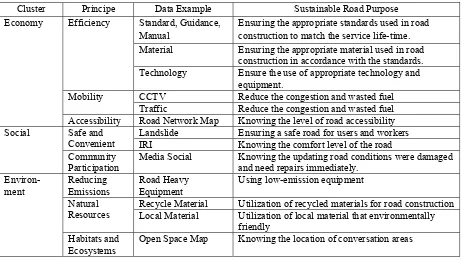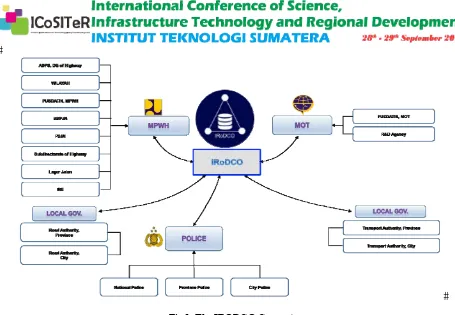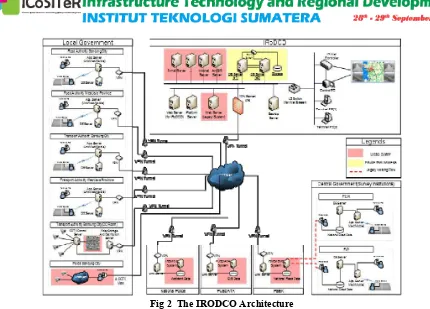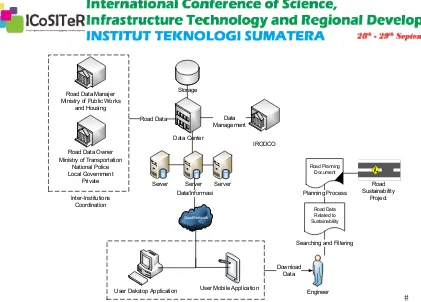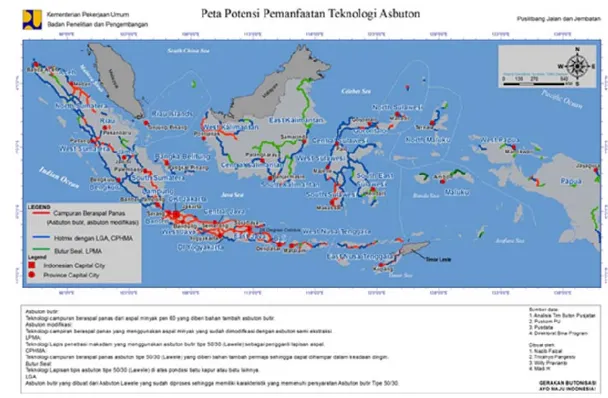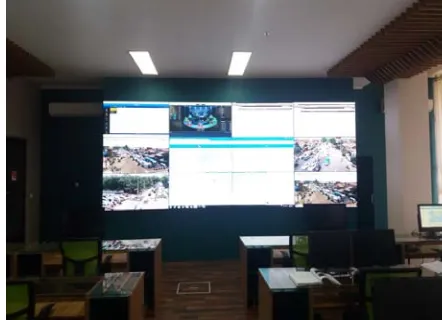40
Indonesian Road Data Center (IRODCO) for Supporting Sustainable
Road Development
Dimas Sigit Dewandaru1, Nazib Faizal2, Arief Bachtiar3
1 Institute of Road Engineering, Ministry of Public Works and Housing, Republic of Indonesia. Jl. A. H.
Nasution No.264 Bandung 40294 Indonesia)
2Institute of Road Engineering, Ministry of Public Works and Housing, Republic of Indonesia. Jl. A. H.
Nasution No.264 Bandung 40294 Indonesia)
3Institute of Road Engineering, Ministry of Public Works and Housing, Republic of Indonesia. Jl. A. H.
Nasution No.264 Bandung 40294 Indonesia)
1[email protected], 2[email protected], 3[email protected]
Abstract
One of the problems on current road infrastructure development in Indonesia is the difficulty of getting road data and information. For example, data and information, which related on sustainable road infrastructure development. Moreover, some of road authorities did not realize that data is important element in the cycle process of road infrastructure development. Inaccurate road data will decrease the quality of road budgeting and programming, on the other hand it will affect the period service of road itself. The good road data could support sustainable road by providing the road value such as historical, current condition, and prediction. Indonesian Road Data Center Operations (IRODCO) is a concept of integrated road database storage. Collaborate data from Indonesian road authority (Ministry of Public Work and Housing, Ministry of Transportation, National Police and Local Government) can be stored, processed and managed to be a value-added information. IRODCO will provide data and information easily and quickly, for supporting the sustainable development of road infrastructure. This paper will explain the background of IRODCO concept, type of road database, the architecture, and how this concept will be implemented in Indonesia, particularly for supporting the sustainable road infrastructure development.
Keywords : IRODCO, Road Data, Sustainable Road Development.
I. Introduction
One of the integral part on road construction process is the availability of data. Data representing facts in an array structured. "Generally, data represent a structured of single codification of primary entities, as well as transactions involving two or more primary entities." [1]. In addition, the description of a fact, the data may also represent an object. "Data is the value that represents the description of an object or event"[2]. In the context of road construction, data used as important input for planning process, and used as technical reference for implementation process, as well as a reference for verification in the evaluation process. Without accurate data, construction of roads and bridges will be vulnerable to failures and irregularities.
41
Road data is one of important data that used on sustainable road planning. Good data would affect the implementation of good sustainable road, they will make the life-time service road longer, also create road more green and friendly environment. But it hard to find the complete and accurate road data, due to there is no integrated road data in Indonesia.
Indonesian Road Data center Operation (IRODCO) is a concept of road data base storage system integrated in a data center. Data from various road authorities could be stored, processed and maintained to provide information with added value in it.
This paper examines the concept of IRODCO by analyzing data that owned by various road authorities in Indonesia. The concern of this study is how the IRODCO could support the sustainability road development in Indonesia, by integrating road data system. The result of this study is the concept of IRODCO that can be used as a part of the sustainable road development in Indonesia.
II. Literature Review
A. Sustainable Road Development
Sustainable development is a process of development (land, cities, businesses, communities, etc.) that principled "meets the needs of the present without compromising the fulfilment of the needs of future generations" [3]. A variety of development programs that pay attention in the aspects of social, economic, and environment have been proclaimed by many countries and has been a mutual agreement as sustainable development.
Sustainable development is a multidimensional concept, then on it is application, the sustainable development required the input of different disciplines [4], as well as sustainable road development. The concept of a sustainable road or also called as green road have the same approach with sustainable development, that is need of a comprehensive and integrated planning that it influence on the economic, social, and environment [5].
Ref Lawalata [6], explains that there are principles that must be aligned with the concept of sustainable road, namely efficiency, mobility, accessibility, good and convenient, community participation, capping emissions, natural resources, habitats, and ecosystems. One of the principles of sustainable road is efficiency, which greatly influences the level of sustainability of road construction. Good planning taking into account the level of efficiency, can extend the life-time of road and minimizing the service maintenance, as well as rehabilitation of the road. However, the good planning to support the sustainable road development requires a data which are complete and accurate.
B. Road Data
Data that used by IRODCO are the electronic data (digital) from processing computing devices (computers) or originally written then converted into the digital data. Electronic data refers to any original script and a copy of the non-identical computer processing of results [7]. Road data referred to in this paper are all electronic data associated with the field of roads. Road data can be either raw data survey results, statistical data, graphics, multimedia or spatial data.
42
C. Legal Aspects of Data
In Indonesia, until now there are has not been a specific set of rules about data management. As for the regulations still have linkages with data management is the ACT of statistics, Company Documents and ACT on information and Electronic Transaction LAW (ITE). ACT No. 4 of 1997 about the Statistics, the article 1 said that "Data is the information that a number of characteristics (special features) become a population', but further discussion in this LEGISLATURE focus more to the statistics. As for the LAW No. 8 of 1997 about the definition of corporate documents written or printed data called documents, but further to this ACT focuses on document management within the company.
Regulation has many linkages with data in particular electronic data in relation towards the collection, processing, storage to the data distribution is the LAW No. 11 in 2008 about ITE. Security and crime always met in a variety of issues related to information and electronic transactions (ITE), so that it is featured in several articles in the ACT ITE [9].
D. Data Center
One of the important components in the process of road data integration is data center. According to Yulianti [10] data center is a facility used for the placement of some groups of servers or computer systems and data storage systems (storage). In the case of integration data of road, they need some computer servers to process management, storage and distribution of data. It is in accordance with the data center functions as a collection of server or computer room [11].
Currently the Ministry of Public Works and Housing Republic of Indonesia has had a managed data center at Data and Information Center (Pusdatin). Other data center is owned by Institute of Road Engineering (IRE) in Bandung, which is currently used as data center for IRODCO project.
III. Discussion
A. Road Data Needs for Sustainable Road
Currently, road data are scattered in the various institutions, such as Ministry of Public Works and Housing, Ministry of Transportation, Central Bureau of Statistics, local government, state-owned enterprises and private company (consultants and contractors). The data that they have been maintained in accordance with the duties and functions of each institution. However, the data manage partially, although data management occurs in one institution. The Diversity of road data is common between the divisions of the organization, it also common in organizations that have branches in different regions. The different condition of the infrastructure of information and communication technology in each region can caused some application that has been developed by the Head Office, cannot be used [12].
Table 1 show the distribution of the road data that owned by various institutions in Indonesia. The road data is example from several institutions in the scope of study of IRODCO (compiled from various sources).
Table 1 Road Data Source in Indonesia
No Institutions Road Data Type of Data
1 Data and Information Center Ministry of Public Works and Housing
a. National Road Network b. Road Network Planning c. National Road Map
Tabular/Numerik Spatial
43
d. Road Heavy Equipment Location Map
2 Directorate General of Highway Ministry of Public Works and Housing
a. IRI (International Roughness Index) b. SDI (Surface Distress Index) c. Daily Traffic Counting d. National Road Network e. National Bridge Network f. National Road Condition g. National Bridge Condition h. National Road Project
Tabular/Numerik Spatial
Report
No Institutions Road Data
3 Institute of Road Engineering Ministry of Public Works and Housing
a. Road and Bridge R&D
b. Asphalt Buton (Natural Rock Asphalt) Deposit c. SSI j. Green Road Technology k. Green Material
l. Low Emission Material
Tabular/Numerik Spatial
Report
4 Ministry of Transportation a. CCTV/Video Streaming) b. Accident
5 National Police a. Local Road Network b. Street Lighting
c. Local Road and Bridge Infrastructure Map d. Local Transportation Mode 7 Stated-Owned Enterprises
Private Company a. Toll Road Network b. Toll CCTV c. As Built Drawing
d. Road Construction Project Planning e. Road Construction Project Report f. Green Road Technology
Tabular/Numerik Spatial
44
Based on table of Road Data Source in Indonesia (table 1), it can be seen that each institution maintained several road data. Other things that can be seen from table 1 are the road data that scattered in various institutions have vulnerable to duplication of data, although the duplication of data could effected by primary tasks of each institution. In the case of table 1, the available data can be grouped into several clusters to facilitate data analysis.
Related the case of sustainable road, the road data in Indonesia can be clustered into three groups, namely the economic, social and environmental. Grouping data based on the principle of sustainability in construction. In accordance with Lawalata [6] who explains the principle of sustainable road are accessibility, mobility, efficiency, safe and convenient, community participation, capping emissions, natural resources, habitats, and ecosystems. Table 2 gives examples of the utilization of the road data from the various institutions that can be used as an indicator of sustainable road development.
Table 2 Used of Road Data for Sustainable Road Purpose
Cluster Principe Data Example Sustainable Road Purpose Economy Efficiency Standard, Guidance,
Manual Ensuring the appropriate standards used in road construction to match the service life-time. Material Ensuring the appropriate material used in road
construction in accordance with the standards. Technology Ensure the use of appropriate technology and
equipment.
Mobility CCTV Reduce the congestion and wasted fuel Traffic Reduce the congestion and wasted fuel Accessibility Road Network Map Knowing the level of road accessibility Social Safe and
Convenient LandslideIRI Ensuring a safe road for users and workers Knowing the comfort level of the road Community
Participation Media Social Knowing the updating road conditions were damaged and need repairs immediately.
Environ-ment Reducing Emissions Road Heavy Equipment Using low-emission equipment Natural
Resources Recycle MaterialLocal Material Utilization of recycled materials for road constructionUtilization of local material that environmentally friendly
Habitats and
Ecosystems Open Space Map Knowing the location of conversation areas
A. IRODCO Concepts
45
Table 3 Aspect on IRODCO Concept
Aspect Hardware Application
Development Data Management Coordination Data center
Related on the aspect of hardware, the most important thing is the availability of the data center. The organization who manage the road data must have the data centers that comply with the standard TIA 942 issued by American standards, this standard is an international reference standard, even more Indonesia did not have specific standards for the construction of a data center yet. Moreover, the existence of multiple data storage devices (storage) and computer services (server) that are used for storage and processing of the data. The servers are customized to each function of the data to be stored. Internet connection is used as the data distribution, both of input and output to and from data center.
Application development referred in IRODCO is the development of software that will be used in the whole process of the IRODCO activity. The database serves as the data storage management in the data center. Data from the various institutions will be stored in a database in accordance with the type and designation of the data. In the case of various data and big data, they need a structured and efficient data base, then searching for the road data can be find easily. Website required as a media for interaction and distribution data from data center to public. Supporting application used to support the distribution of development result of the database, e.g. mobile applications.
The most important aspect in IRODCO concept is the data management process, due to all activities performed with the data involves the interaction of the various components. This process starts from data collection carried out by the institution as owner of road data. Data collection was carried out online by electronic data transfer via internet connections to the data center. Data which has been stored in data center will be classified by adjusting the database. The data processing is performed to generate the information needed by the user. The information and data that has been processed will be governed and controlled by the data management system. Finally the data and information will be distributed to public in need.
46
Fig 1 The IRODCO Concept
The IRODCO Concept Diagram based on Fig.1 describes the core of the concept of IRODCO is the integrated road data which is collected to the data center. The organization of IRODCO is independent institution, it is mean the organization was formed by placing the members of institutions who join with IRODCO project.
B. IRODCO Architecture
IRODCO architecture can be described with two approaches, first is operational architecture and second is data processing architecture. Both architectures are used in a data integration system. Architectural operating system focus on the design of the overall system, where the data processing included. While the operation of the data architecture describes the process of identifying the data from the beginning of the process until the final results of data in the form of online documents.
Operational architecture illustrates the integration of four aspects which described in IRODCO concept. Data collected from the institutions through online data using information technology. Data that has been sent to the data center will be deposited into storage with a database format that has been determined. The data processed by multiple servers as intended. For examples, the spatial data will be processed by the server GIS (Geographical Information System).
47
Fig 2 The IRODCO Architecture
The IRODCO Architecture based on Fig.2 describes the IRODCO Pilot Project that connected seven institutions (pilot project in Bandung). All institution will connect using the oracle-based platform integration. Data connection to each institution will use Virtual Private Network (VPN). The use of those lines are expected to enhance the security of data communications on this system.
Each institution incorporated with IRODCO system will get a desktop application as a portal for input their data. Some institutions will be equipped with a mobile application and CCTV based application to facilitate data sharing. The data which have been collected in data center will be displayed in the Network Operation Center (NOC), and will be shared through IRODCO website to the users who need it.
C. IRODCO Support for Sustainable Road Development
Sustainable road development requires complete and accurate road data support. Complete means the data has continuity history and periodically, and they have attributes that match to the purpose. While accurate data means they having updated periodically and is derived from sources that are obvious. According to Anwar [13], an effective data management factor are the updated time, the accuracy of inputting data, the maintenance data that stored in the system, the purposes of data security that is already in use, as well as adequate back-up facilities..
Fig 3 IRODCO Support Sustainable Road Illustration
IRODCO Support Sustainable Road Illustration based on Fig.3 illustrates how IRODCO could support the sustainable road development. The road data has been collected from institutions stored and processed in the Data Center (IRODCO). The road data information will be shared to the public via internet or desktop applications. Public who want to access the data, could access IRODCO.
Road data that has been downloaded from IRODCO can be used according to needs of users, for example for sustainable road development analysis. Data that has been downloaded can be used in programming or advanced analysis, so it can create the good sustainable road development plan. An example is the utilization of potential technology Asbuton (Figure 4) which can be downloaded from IRODCO. Users can utilize this data to find out the location of the utilization of environment-friendly local materials used in road construction. The data can be used by engineering for planning process in sustainable road construction project.
49
Fig 4 The Potential Utilization Of Technology Asbuton.
Related to the development and dissemination of sustainable road technologies, IRODCO could be one of the solutions to share the information and knowledge over the country of Indonesia. The utilization of information technology with internet access can distribute road data to the farthest regions in Indonesia. It can support the Government's program in order to open the information widely to remote areas. Look at the population of Indonesia which is on number five in the world and considering geographical condition that Indonesia is an archipelago, then it can be ascertained that the need for Information Communication Technology (ICT) a reliable becomes an important issue [14].
D. IRODCO Current Work
50
Fig 5 IRODCO Current Network Operation Center (NOC) in IRE
IV. Conclusion
Sustainable development is an issue that continues to grow in the world, along with the increasing awareness that development must pay attention to the principle of "meeting the needs of the present without compromising the fulfillment of the needs of future generations". One of its derivatives is the concept of sustainable road, i.e. road construction with a bunch of attention to economic, social, and environmental. Sustainable road development can be successful if supported with good planning. However, good planning requires good data. So it need a data center for connecting the needs of user (public) with the owner of the road data.
Currently in Indonesia, there is no system that can integrate road data. IRODCO is a data integration concept that utilizes data center to manage and produce information that is useful, such as for sustainable road development. IRODCO concept built by developing the database system that has owned by various institutions. This system offers a way for data sharing to all users with variety of purposes. Various data which have been stored in IRODCO, they being process and system will allow users to getting the information, such as conducting study that support sustainable road development. With the existence of IRODCO, the development of sustainable road in Indonesia getting easily. The complete and accurate data that support sustainable road could find in internet everywhere and every time.IRODCO is one solution for Indonesia engineer to improve their program for support sustainable road development.
R
EFERENCES[1] Vercellis, C, “Business Intelligence: Data Mining and Optimization for Decision Making (1sted.)”.
Wiley. 2009
[2] Munir. Wawan, “Pengantar Sistem Informasi”, Graha Ilmu, Yogyakarta. Indonesia. 2006.
[3] Litman. T. 2011. Measuring Transportation. Traffic. Mobility. And Accessibility,[Online] Available : Victoria Transport Policy Institute. Victoria.www.vtpi.org.
51
[5] Greenberg, E. 2008. “Sustainable Streets: An Emerging Practice’, [Online] ITE Journal. Pp 29-39, Available: http://www.ite.org/meetings/2010TC/Session%25206%2520Ellen%2520Greenberg.pdf.
[6] Lawalata. G.M, “Prinsip-Prinsip Pembangunan Jalan Berkelanjutan” Jurnal Transportasi Vol. 13 No. 2 p 115-124, Agustus, 2013.
[7] Oracle. Definition of Electronic Data. [Online], Available : http://www.dba-oracle.com/t_electronic_ data_definition.htm
[8] Jogiyanto, Hartono, “Analisis & Desain Sistem Informasi Pendekatan Terstruktur Teori dan Praktek Aplikasi Bisnis”, Andi Yogyakarta. Indonesia. 2005.
[9] Nasution, Fitria. 2013. Makalah UU ITE. [Online], Available: http://makalahkomputerfitri. blogspot.com/2013/06/makalah-uu-ite.html
[10] Yulianti, Eka, & Nanda, Bayu. 2008. Best Practice Perancangan Fasilitas Data center. [Onine], Available: Opencontent.org.
[11] Bullock, Michael. 2009. Data center Definition and Solutions, [Online], Available : http://www.cio.com/article/499671/ Data_Center_Definition_and_Solutions#what
[12] Kridalukmana, Rinta. 2011. Penanganan Keragaman Pengelolaan Data dan Infrastuktur
[13] Teknologi Informasi. [Online], Available: http://digilib.itb.ac.id/gdl.php?mod=browse&op= read&id=jbptitbpp-gdl-rintakrida-29048.
[14] Anwar Prabu Mangkunegara. “Manajemen Sumber Daya Manusia. Perusahaan cetakan pertama”, PT. Remaja Rsodakarya, Bandung, Indonesia, 2004.
